Influence of Leininger’s Culture Care Theory on Nursing Values and Goals
VerifiedAdded on 2023/04/22
|9
|2340
|253
AI Summary
This article discusses the influence of Leininger’s Culture Care Theory on nursing values and goals. It also covers prominent nursing figures, nursing organizations, and leadership qualities of nursing excellence.
Contribute Materials
Your contribution can guide someone’s learning journey. Share your
documents today.
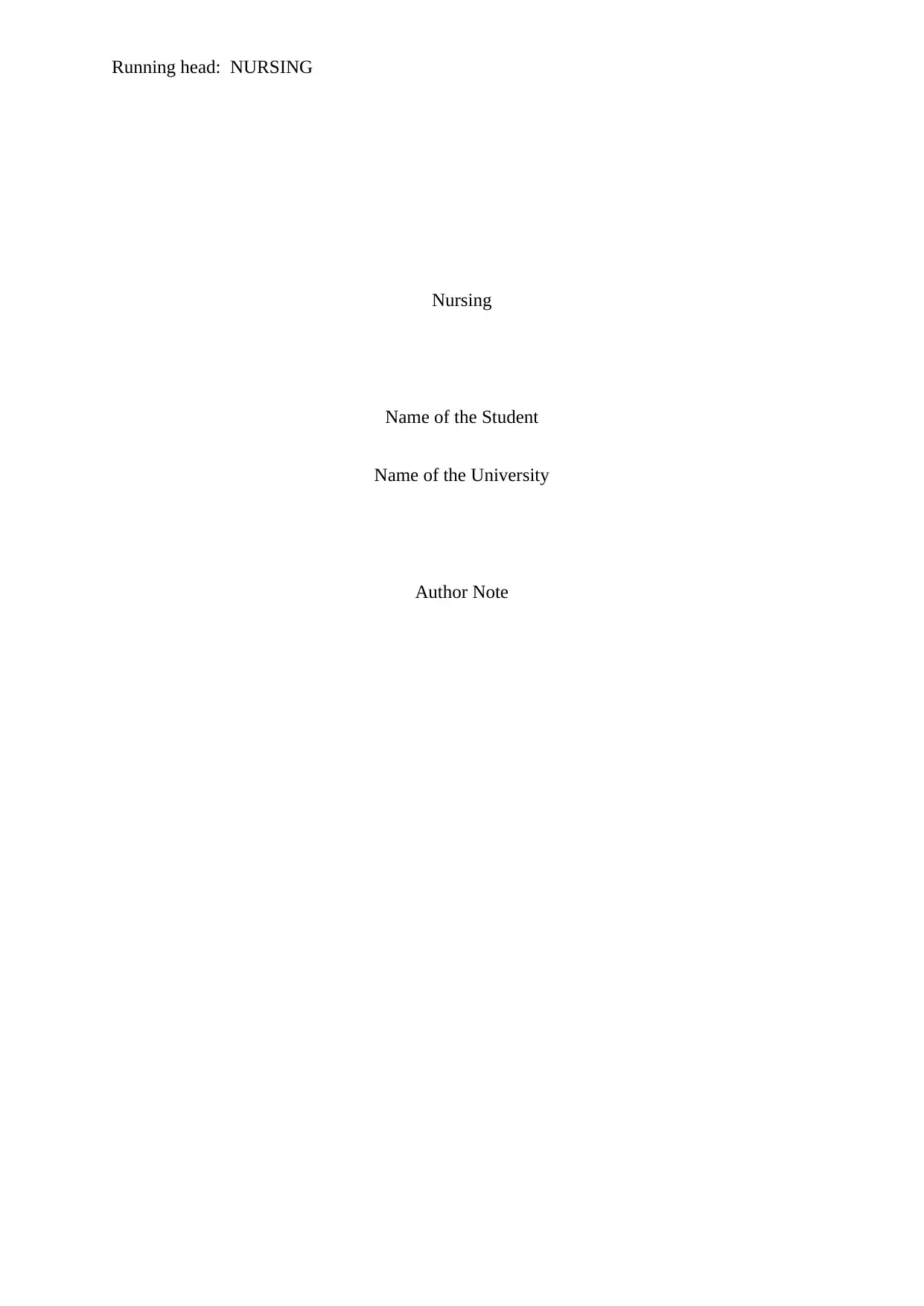
Running head: NURSING
Nursing
Name of the Student
Name of the University
Author Note
Nursing
Name of the Student
Name of the University
Author Note
Secure Best Marks with AI Grader
Need help grading? Try our AI Grader for instant feedback on your assignments.
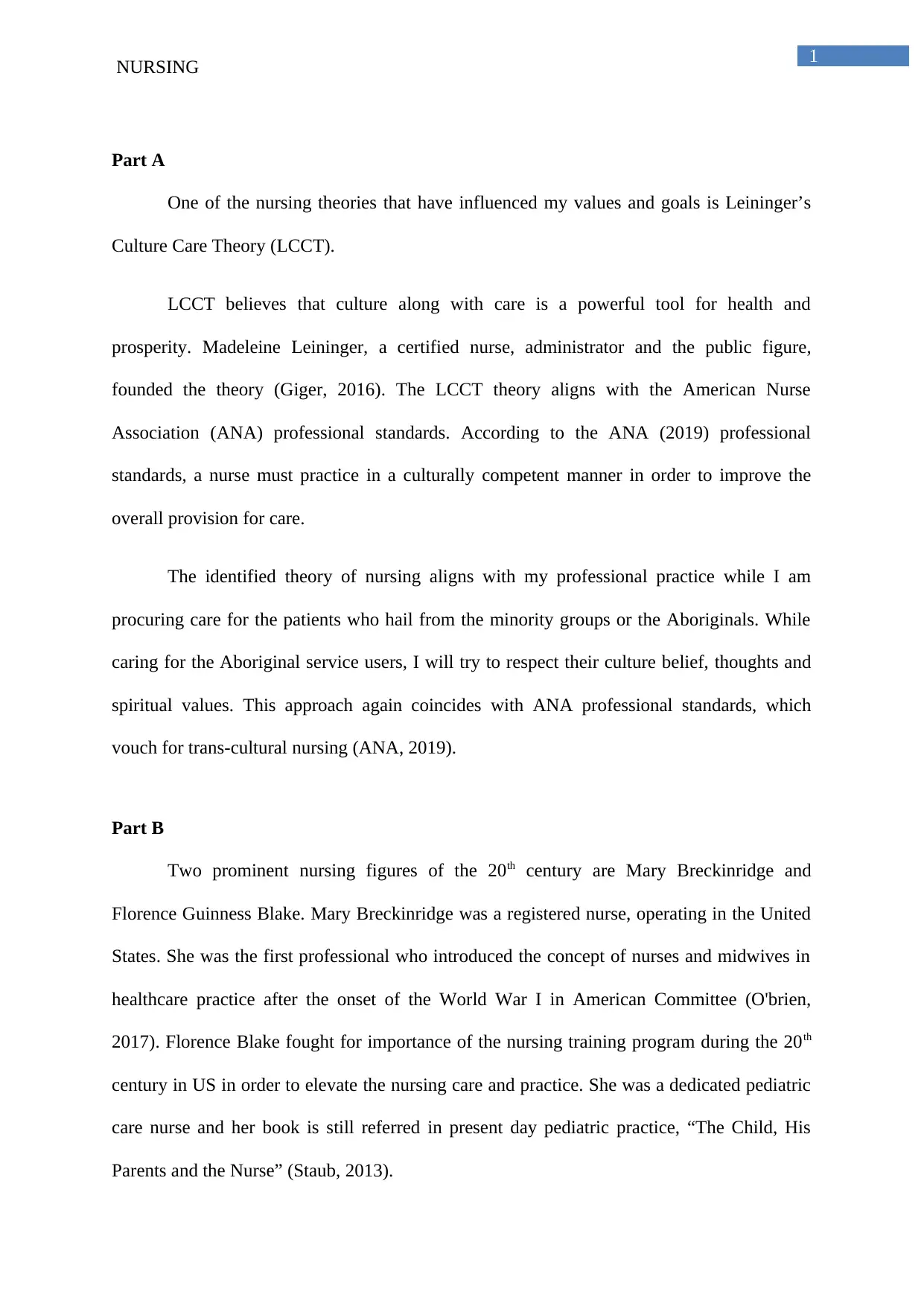
1
NURSING
Part A
One of the nursing theories that have influenced my values and goals is Leininger’s
Culture Care Theory (LCCT).
LCCT believes that culture along with care is a powerful tool for health and
prosperity. Madeleine Leininger, a certified nurse, administrator and the public figure,
founded the theory (Giger, 2016). The LCCT theory aligns with the American Nurse
Association (ANA) professional standards. According to the ANA (2019) professional
standards, a nurse must practice in a culturally competent manner in order to improve the
overall provision for care.
The identified theory of nursing aligns with my professional practice while I am
procuring care for the patients who hail from the minority groups or the Aboriginals. While
caring for the Aboriginal service users, I will try to respect their culture belief, thoughts and
spiritual values. This approach again coincides with ANA professional standards, which
vouch for trans-cultural nursing (ANA, 2019).
Part B
Two prominent nursing figures of the 20th century are Mary Breckinridge and
Florence Guinness Blake. Mary Breckinridge was a registered nurse, operating in the United
States. She was the first professional who introduced the concept of nurses and midwives in
healthcare practice after the onset of the World War I in American Committee (O'brien,
2017). Florence Blake fought for importance of the nursing training program during the 20th
century in US in order to elevate the nursing care and practice. She was a dedicated pediatric
care nurse and her book is still referred in present day pediatric practice, “The Child, His
Parents and the Nurse” (Staub, 2013).
NURSING
Part A
One of the nursing theories that have influenced my values and goals is Leininger’s
Culture Care Theory (LCCT).
LCCT believes that culture along with care is a powerful tool for health and
prosperity. Madeleine Leininger, a certified nurse, administrator and the public figure,
founded the theory (Giger, 2016). The LCCT theory aligns with the American Nurse
Association (ANA) professional standards. According to the ANA (2019) professional
standards, a nurse must practice in a culturally competent manner in order to improve the
overall provision for care.
The identified theory of nursing aligns with my professional practice while I am
procuring care for the patients who hail from the minority groups or the Aboriginals. While
caring for the Aboriginal service users, I will try to respect their culture belief, thoughts and
spiritual values. This approach again coincides with ANA professional standards, which
vouch for trans-cultural nursing (ANA, 2019).
Part B
Two prominent nursing figures of the 20th century are Mary Breckinridge and
Florence Guinness Blake. Mary Breckinridge was a registered nurse, operating in the United
States. She was the first professional who introduced the concept of nurses and midwives in
healthcare practice after the onset of the World War I in American Committee (O'brien,
2017). Florence Blake fought for importance of the nursing training program during the 20th
century in US in order to elevate the nursing care and practice. She was a dedicated pediatric
care nurse and her book is still referred in present day pediatric practice, “The Child, His
Parents and the Nurse” (Staub, 2013).
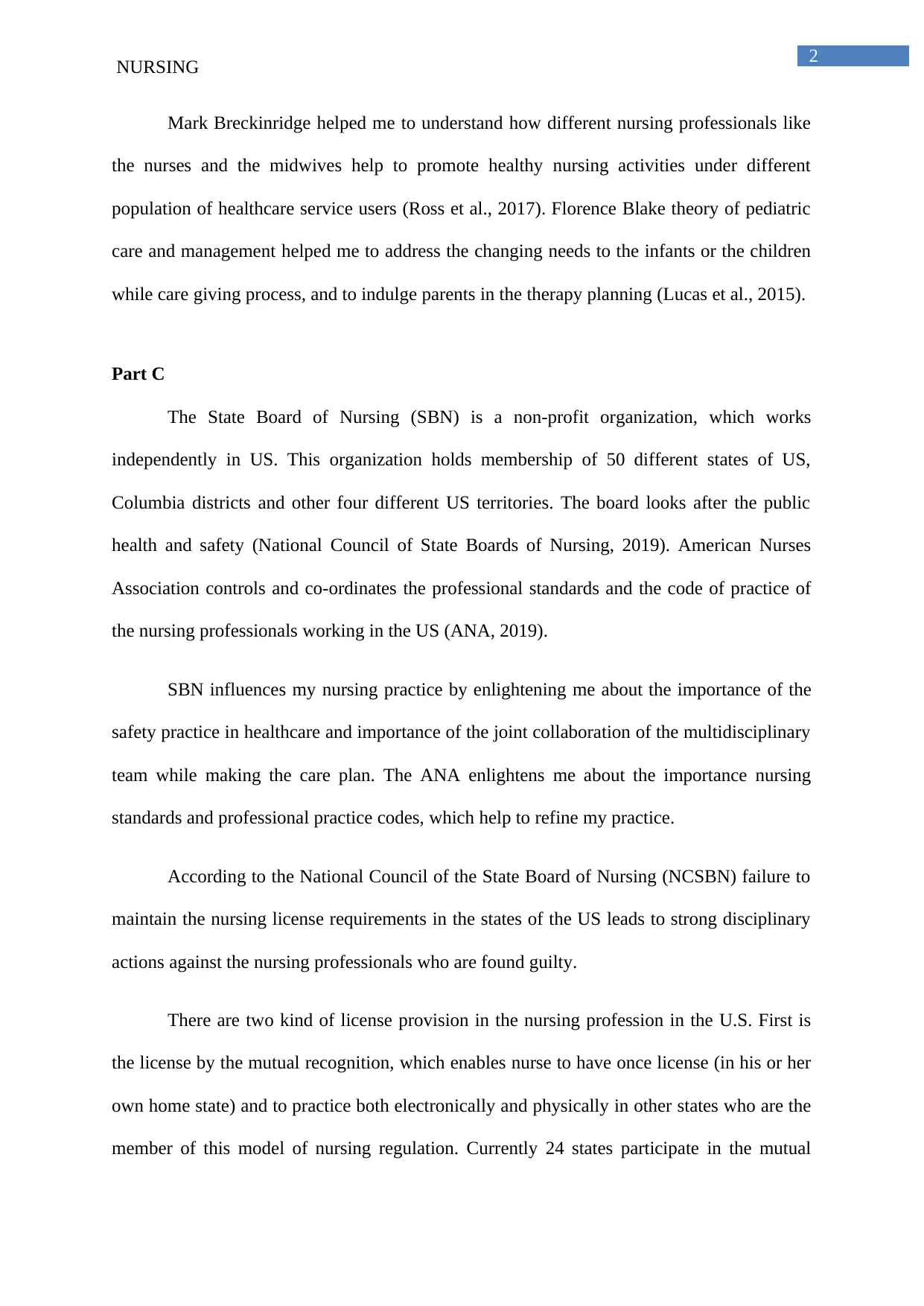
2
NURSING
Mark Breckinridge helped me to understand how different nursing professionals like
the nurses and the midwives help to promote healthy nursing activities under different
population of healthcare service users (Ross et al., 2017). Florence Blake theory of pediatric
care and management helped me to address the changing needs to the infants or the children
while care giving process, and to indulge parents in the therapy planning (Lucas et al., 2015).
Part C
The State Board of Nursing (SBN) is a non-profit organization, which works
independently in US. This organization holds membership of 50 different states of US,
Columbia districts and other four different US territories. The board looks after the public
health and safety (National Council of State Boards of Nursing, 2019). American Nurses
Association controls and co-ordinates the professional standards and the code of practice of
the nursing professionals working in the US (ANA, 2019).
SBN influences my nursing practice by enlightening me about the importance of the
safety practice in healthcare and importance of the joint collaboration of the multidisciplinary
team while making the care plan. The ANA enlightens me about the importance nursing
standards and professional practice codes, which help to refine my practice.
According to the National Council of the State Board of Nursing (NCSBN) failure to
maintain the nursing license requirements in the states of the US leads to strong disciplinary
actions against the nursing professionals who are found guilty.
There are two kind of license provision in the nursing profession in the U.S. First is
the license by the mutual recognition, which enables nurse to have once license (in his or her
own home state) and to practice both electronically and physically in other states who are the
member of this model of nursing regulation. Currently 24 states participate in the mutual
NURSING
Mark Breckinridge helped me to understand how different nursing professionals like
the nurses and the midwives help to promote healthy nursing activities under different
population of healthcare service users (Ross et al., 2017). Florence Blake theory of pediatric
care and management helped me to address the changing needs to the infants or the children
while care giving process, and to indulge parents in the therapy planning (Lucas et al., 2015).
Part C
The State Board of Nursing (SBN) is a non-profit organization, which works
independently in US. This organization holds membership of 50 different states of US,
Columbia districts and other four different US territories. The board looks after the public
health and safety (National Council of State Boards of Nursing, 2019). American Nurses
Association controls and co-ordinates the professional standards and the code of practice of
the nursing professionals working in the US (ANA, 2019).
SBN influences my nursing practice by enlightening me about the importance of the
safety practice in healthcare and importance of the joint collaboration of the multidisciplinary
team while making the care plan. The ANA enlightens me about the importance nursing
standards and professional practice codes, which help to refine my practice.
According to the National Council of the State Board of Nursing (NCSBN) failure to
maintain the nursing license requirements in the states of the US leads to strong disciplinary
actions against the nursing professionals who are found guilty.
There are two kind of license provision in the nursing profession in the U.S. First is
the license by the mutual recognition, which enables nurse to have once license (in his or her
own home state) and to practice both electronically and physically in other states who are the
member of this model of nursing regulation. Currently 24 states participate in the mutual
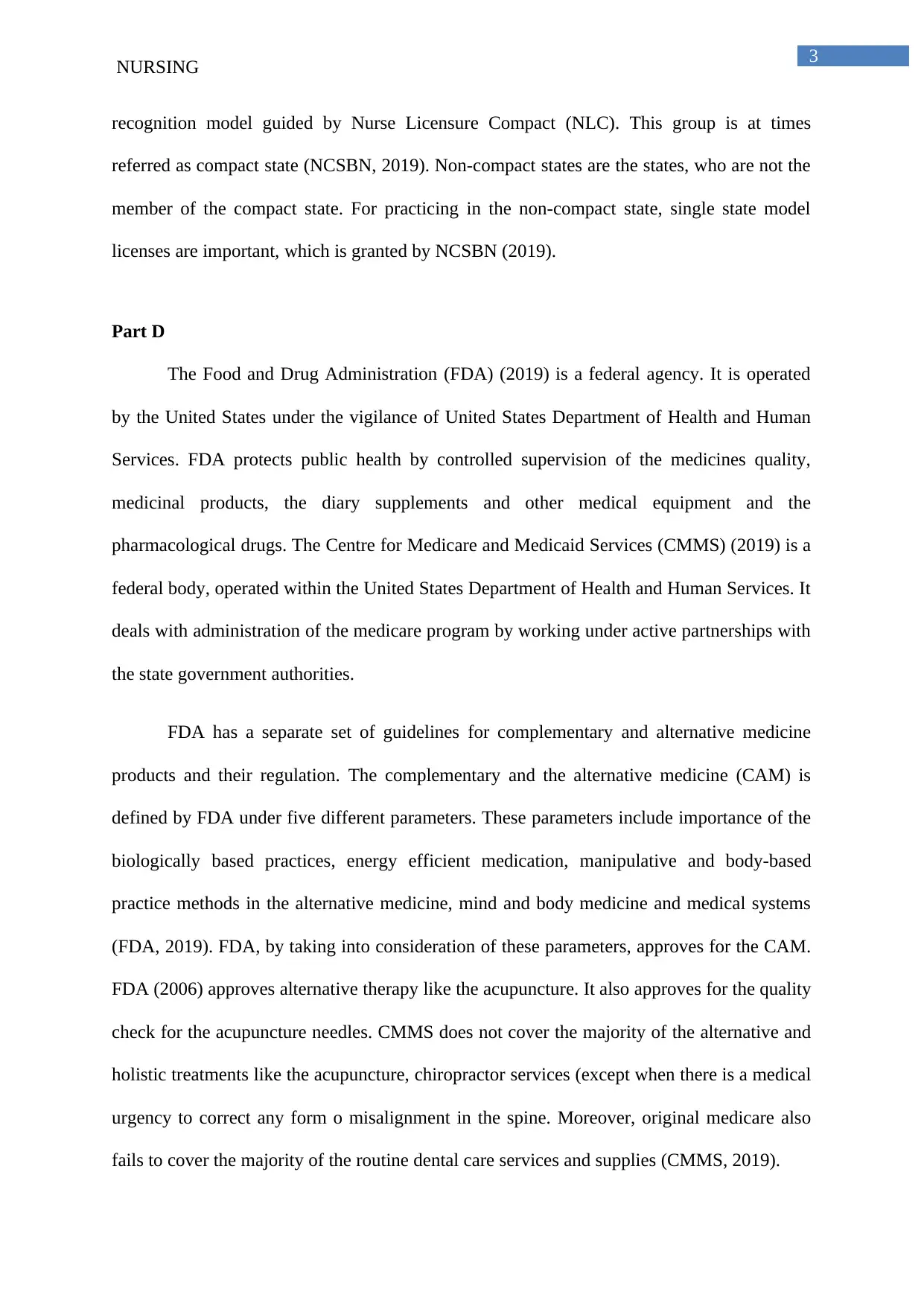
3
NURSING
recognition model guided by Nurse Licensure Compact (NLC). This group is at times
referred as compact state (NCSBN, 2019). Non-compact states are the states, who are not the
member of the compact state. For practicing in the non-compact state, single state model
licenses are important, which is granted by NCSBN (2019).
Part D
The Food and Drug Administration (FDA) (2019) is a federal agency. It is operated
by the United States under the vigilance of United States Department of Health and Human
Services. FDA protects public health by controlled supervision of the medicines quality,
medicinal products, the diary supplements and other medical equipment and the
pharmacological drugs. The Centre for Medicare and Medicaid Services (CMMS) (2019) is a
federal body, operated within the United States Department of Health and Human Services. It
deals with administration of the medicare program by working under active partnerships with
the state government authorities.
FDA has a separate set of guidelines for complementary and alternative medicine
products and their regulation. The complementary and the alternative medicine (CAM) is
defined by FDA under five different parameters. These parameters include importance of the
biologically based practices, energy efficient medication, manipulative and body-based
practice methods in the alternative medicine, mind and body medicine and medical systems
(FDA, 2019). FDA, by taking into consideration of these parameters, approves for the CAM.
FDA (2006) approves alternative therapy like the acupuncture. It also approves for the quality
check for the acupuncture needles. CMMS does not cover the majority of the alternative and
holistic treatments like the acupuncture, chiropractor services (except when there is a medical
urgency to correct any form o misalignment in the spine. Moreover, original medicare also
fails to cover the majority of the routine dental care services and supplies (CMMS, 2019).
NURSING
recognition model guided by Nurse Licensure Compact (NLC). This group is at times
referred as compact state (NCSBN, 2019). Non-compact states are the states, who are not the
member of the compact state. For practicing in the non-compact state, single state model
licenses are important, which is granted by NCSBN (2019).
Part D
The Food and Drug Administration (FDA) (2019) is a federal agency. It is operated
by the United States under the vigilance of United States Department of Health and Human
Services. FDA protects public health by controlled supervision of the medicines quality,
medicinal products, the diary supplements and other medical equipment and the
pharmacological drugs. The Centre for Medicare and Medicaid Services (CMMS) (2019) is a
federal body, operated within the United States Department of Health and Human Services. It
deals with administration of the medicare program by working under active partnerships with
the state government authorities.
FDA has a separate set of guidelines for complementary and alternative medicine
products and their regulation. The complementary and the alternative medicine (CAM) is
defined by FDA under five different parameters. These parameters include importance of the
biologically based practices, energy efficient medication, manipulative and body-based
practice methods in the alternative medicine, mind and body medicine and medical systems
(FDA, 2019). FDA, by taking into consideration of these parameters, approves for the CAM.
FDA (2006) approves alternative therapy like the acupuncture. It also approves for the quality
check for the acupuncture needles. CMMS does not cover the majority of the alternative and
holistic treatments like the acupuncture, chiropractor services (except when there is a medical
urgency to correct any form o misalignment in the spine. Moreover, original medicare also
fails to cover the majority of the routine dental care services and supplies (CMMS, 2019).
Secure Best Marks with AI Grader
Need help grading? Try our AI Grader for instant feedback on your assignments.

4
NURSING
Part E
According to the Nursing Practice Act based on the nursing professionals operating in
Florida, a nursing professionals who has registered license in a state, which is a member of
the compact state like the Utah. According to the Nursing Practice Act, a nursing professional
who has a license of a compact state like Utah or Florida (Nurse Licensure Compact: NLC)
cannot practice in a non-compact state like California. This is because, as per the guidelines
of the Nursing Practice Act, a nurse whose primary state of residence is under a non-compact
state, he or she is not eligible for compact license.
NLC allows a nurse (RN: Registered nurse and LPN: licensed practical nurse /VN:
licensed vocational nurse) to have one compact nursing license in nurse’s primary state of
residence (at the home state) and to practice in other compact state like other remote states.
Like a nurse, having license in Florida can practice in Utah. A compact license RN and
LPN/VN can practice both physically, electronically and telephonically. The Advanced
Practice Registered nurses (APRNs) are not enrolled in this compact. APRNs must apply for
license in each state separately. An unlicensed assistive personnel can only assist nurses can
cannot directly participate in the care program (National Council of the State Board of
Nursing (NCSBN), 2018).
The rule of the effective delegation for the unlicensed assistive personnel in Florida
includes communication with patients and assisting the registered nursing professionals. For
delegation for the registered nursing professionals, include training the nursing sub-ordinates
and procuring care to the patients by avoiding potential harm (Florida Administrative Code
and Florida Administrative Register, 2019). The assignment and delegation for the nursing
professionals (licensed and non-licensed) in California, a non-compact state is same that of
Florida. The role registered nursing professionals is to train the subordinate nurses and to
NURSING
Part E
According to the Nursing Practice Act based on the nursing professionals operating in
Florida, a nursing professionals who has registered license in a state, which is a member of
the compact state like the Utah. According to the Nursing Practice Act, a nursing professional
who has a license of a compact state like Utah or Florida (Nurse Licensure Compact: NLC)
cannot practice in a non-compact state like California. This is because, as per the guidelines
of the Nursing Practice Act, a nurse whose primary state of residence is under a non-compact
state, he or she is not eligible for compact license.
NLC allows a nurse (RN: Registered nurse and LPN: licensed practical nurse /VN:
licensed vocational nurse) to have one compact nursing license in nurse’s primary state of
residence (at the home state) and to practice in other compact state like other remote states.
Like a nurse, having license in Florida can practice in Utah. A compact license RN and
LPN/VN can practice both physically, electronically and telephonically. The Advanced
Practice Registered nurses (APRNs) are not enrolled in this compact. APRNs must apply for
license in each state separately. An unlicensed assistive personnel can only assist nurses can
cannot directly participate in the care program (National Council of the State Board of
Nursing (NCSBN), 2018).
The rule of the effective delegation for the unlicensed assistive personnel in Florida
includes communication with patients and assisting the registered nursing professionals. For
delegation for the registered nursing professionals, include training the nursing sub-ordinates
and procuring care to the patients by avoiding potential harm (Florida Administrative Code
and Florida Administrative Register, 2019). The assignment and delegation for the nursing
professionals (licensed and non-licensed) in California, a non-compact state is same that of
Florida. The role registered nursing professionals is to train the subordinate nurses and to
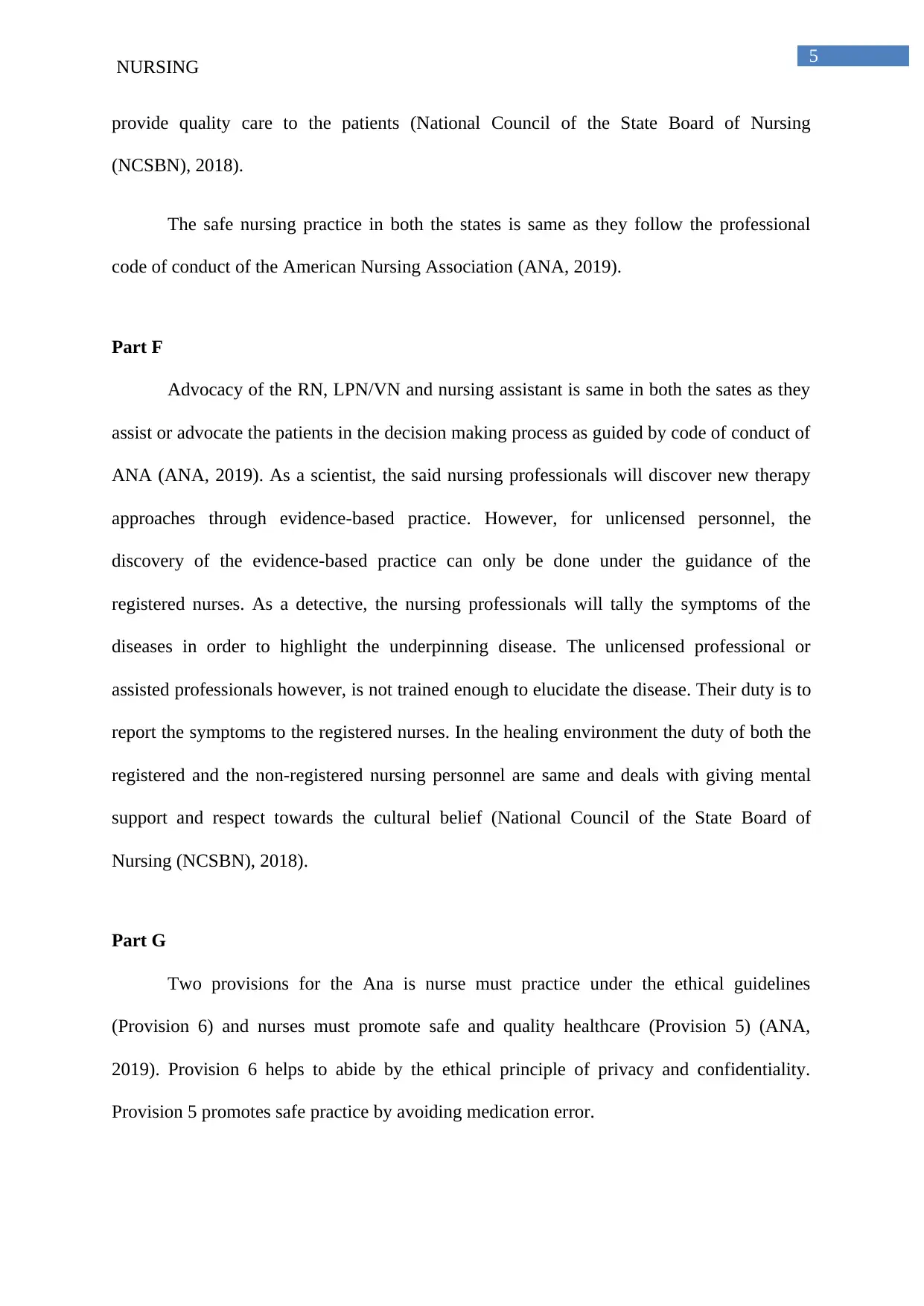
5
NURSING
provide quality care to the patients (National Council of the State Board of Nursing
(NCSBN), 2018).
The safe nursing practice in both the states is same as they follow the professional
code of conduct of the American Nursing Association (ANA, 2019).
Part F
Advocacy of the RN, LPN/VN and nursing assistant is same in both the sates as they
assist or advocate the patients in the decision making process as guided by code of conduct of
ANA (ANA, 2019). As a scientist, the said nursing professionals will discover new therapy
approaches through evidence-based practice. However, for unlicensed personnel, the
discovery of the evidence-based practice can only be done under the guidance of the
registered nurses. As a detective, the nursing professionals will tally the symptoms of the
diseases in order to highlight the underpinning disease. The unlicensed professional or
assisted professionals however, is not trained enough to elucidate the disease. Their duty is to
report the symptoms to the registered nurses. In the healing environment the duty of both the
registered and the non-registered nursing personnel are same and deals with giving mental
support and respect towards the cultural belief (National Council of the State Board of
Nursing (NCSBN), 2018).
Part G
Two provisions for the Ana is nurse must practice under the ethical guidelines
(Provision 6) and nurses must promote safe and quality healthcare (Provision 5) (ANA,
2019). Provision 6 helps to abide by the ethical principle of privacy and confidentiality.
Provision 5 promotes safe practice by avoiding medication error.
NURSING
provide quality care to the patients (National Council of the State Board of Nursing
(NCSBN), 2018).
The safe nursing practice in both the states is same as they follow the professional
code of conduct of the American Nursing Association (ANA, 2019).
Part F
Advocacy of the RN, LPN/VN and nursing assistant is same in both the sates as they
assist or advocate the patients in the decision making process as guided by code of conduct of
ANA (ANA, 2019). As a scientist, the said nursing professionals will discover new therapy
approaches through evidence-based practice. However, for unlicensed personnel, the
discovery of the evidence-based practice can only be done under the guidance of the
registered nurses. As a detective, the nursing professionals will tally the symptoms of the
diseases in order to highlight the underpinning disease. The unlicensed professional or
assisted professionals however, is not trained enough to elucidate the disease. Their duty is to
report the symptoms to the registered nurses. In the healing environment the duty of both the
registered and the non-registered nursing personnel are same and deals with giving mental
support and respect towards the cultural belief (National Council of the State Board of
Nursing (NCSBN), 2018).
Part G
Two provisions for the Ana is nurse must practice under the ethical guidelines
(Provision 6) and nurses must promote safe and quality healthcare (Provision 5) (ANA,
2019). Provision 6 helps to abide by the ethical principle of privacy and confidentiality.
Provision 5 promotes safe practice by avoiding medication error.

6
NURSING
During my clinical practice, I disclosed the private information of the patients to a healthcare
professional who is not directly linked to the case study of the patients. This bridged the
privacy and confidentiality issue. Under provision 6, I will keep the information of the patient
safe ad confidential and will only disclose it upon patient’s informed consent (ANA, 2019)
Part H
Four leadership qualities of nursing excellence include effective communication,
conflict management and effective teamwork and rewards and recognition. A leader at a
bedside must practice effective communication in order to inform the students about the
disease progression. While working within a nursing team, a nursing leader must preach
conflict management in order to maintain unison within the team. While working in
multidisciplinary team, both effective communication along with rewards and recognition are
important for proper flow of the information (Cherry & Jacob, 2016).
An organization structure, which follows transformational leadership model and also
supports rewards and recognitions, helps to promote professional development, decision
making process and also cast a positive impact on the nursing leadership via creating a
positive work environment where all the employees feel motivated to work (Cherry & Jacob,
2016).
NURSING
During my clinical practice, I disclosed the private information of the patients to a healthcare
professional who is not directly linked to the case study of the patients. This bridged the
privacy and confidentiality issue. Under provision 6, I will keep the information of the patient
safe ad confidential and will only disclose it upon patient’s informed consent (ANA, 2019)
Part H
Four leadership qualities of nursing excellence include effective communication,
conflict management and effective teamwork and rewards and recognition. A leader at a
bedside must practice effective communication in order to inform the students about the
disease progression. While working within a nursing team, a nursing leader must preach
conflict management in order to maintain unison within the team. While working in
multidisciplinary team, both effective communication along with rewards and recognition are
important for proper flow of the information (Cherry & Jacob, 2016).
An organization structure, which follows transformational leadership model and also
supports rewards and recognitions, helps to promote professional development, decision
making process and also cast a positive impact on the nursing leadership via creating a
positive work environment where all the employees feel motivated to work (Cherry & Jacob,
2016).
Paraphrase This Document
Need a fresh take? Get an instant paraphrase of this document with our AI Paraphraser

7
NURSING
References
American Nursing Association. (2019). The ANA Center for Ethics and Human Rights.
Access date: 16th Jan 2019. Retrieved from: https://www.nursingworld.org/practice-
policy/nursing-excellence/ethics/
Centre for Medicare and Medicaid Services. (2019). Home. Access date: 16-th of Jan 2019.
Retrieved from: https://www.cms.gov/
Cherry, B., & Jacob, S. R. (2016). Contemporary nursing: Issues, trends, & management.
Elsevier Health Sciences.
Florida Administrative Code and Florida Administrative Register. (2019). Delegation to
Unlicensed Assistive Personnel. Access date: 16-th of Jan 2019. Retrieved from:
https://www.flrules.org/gateway/ChapterHome.asp?Chapter=64B9-14
Food and Drug Administration (FDA). (2018). Home. Access date: 16-th of Jan 2019.
Retrieved from: https://www.fda.gov/default.htm
Food and Drug Administration. (2006). Complementary and Alternative Medicine Products
and Their Regulation by the Food and Drug Administration. date: 16-th of Jan 2019.
Retrieve from:
https://www.fda.gov/downloads/RegulatoryInformation/Guidances/UCM145405.pdf
Giger, J. N. (2016). Transcultural Nursing-E-Book: Assessment and Intervention. Elsevier
Health Sciences.
Lucas, P. J., Cabral, C., Hay, A. D., & Horwood, J. (2015). A systematic review of parent and
clinician views and perceptions that influence prescribing decisions in relation to
NURSING
References
American Nursing Association. (2019). The ANA Center for Ethics and Human Rights.
Access date: 16th Jan 2019. Retrieved from: https://www.nursingworld.org/practice-
policy/nursing-excellence/ethics/
Centre for Medicare and Medicaid Services. (2019). Home. Access date: 16-th of Jan 2019.
Retrieved from: https://www.cms.gov/
Cherry, B., & Jacob, S. R. (2016). Contemporary nursing: Issues, trends, & management.
Elsevier Health Sciences.
Florida Administrative Code and Florida Administrative Register. (2019). Delegation to
Unlicensed Assistive Personnel. Access date: 16-th of Jan 2019. Retrieved from:
https://www.flrules.org/gateway/ChapterHome.asp?Chapter=64B9-14
Food and Drug Administration (FDA). (2018). Home. Access date: 16-th of Jan 2019.
Retrieved from: https://www.fda.gov/default.htm
Food and Drug Administration. (2006). Complementary and Alternative Medicine Products
and Their Regulation by the Food and Drug Administration. date: 16-th of Jan 2019.
Retrieve from:
https://www.fda.gov/downloads/RegulatoryInformation/Guidances/UCM145405.pdf
Giger, J. N. (2016). Transcultural Nursing-E-Book: Assessment and Intervention. Elsevier
Health Sciences.
Lucas, P. J., Cabral, C., Hay, A. D., & Horwood, J. (2015). A systematic review of parent and
clinician views and perceptions that influence prescribing decisions in relation to
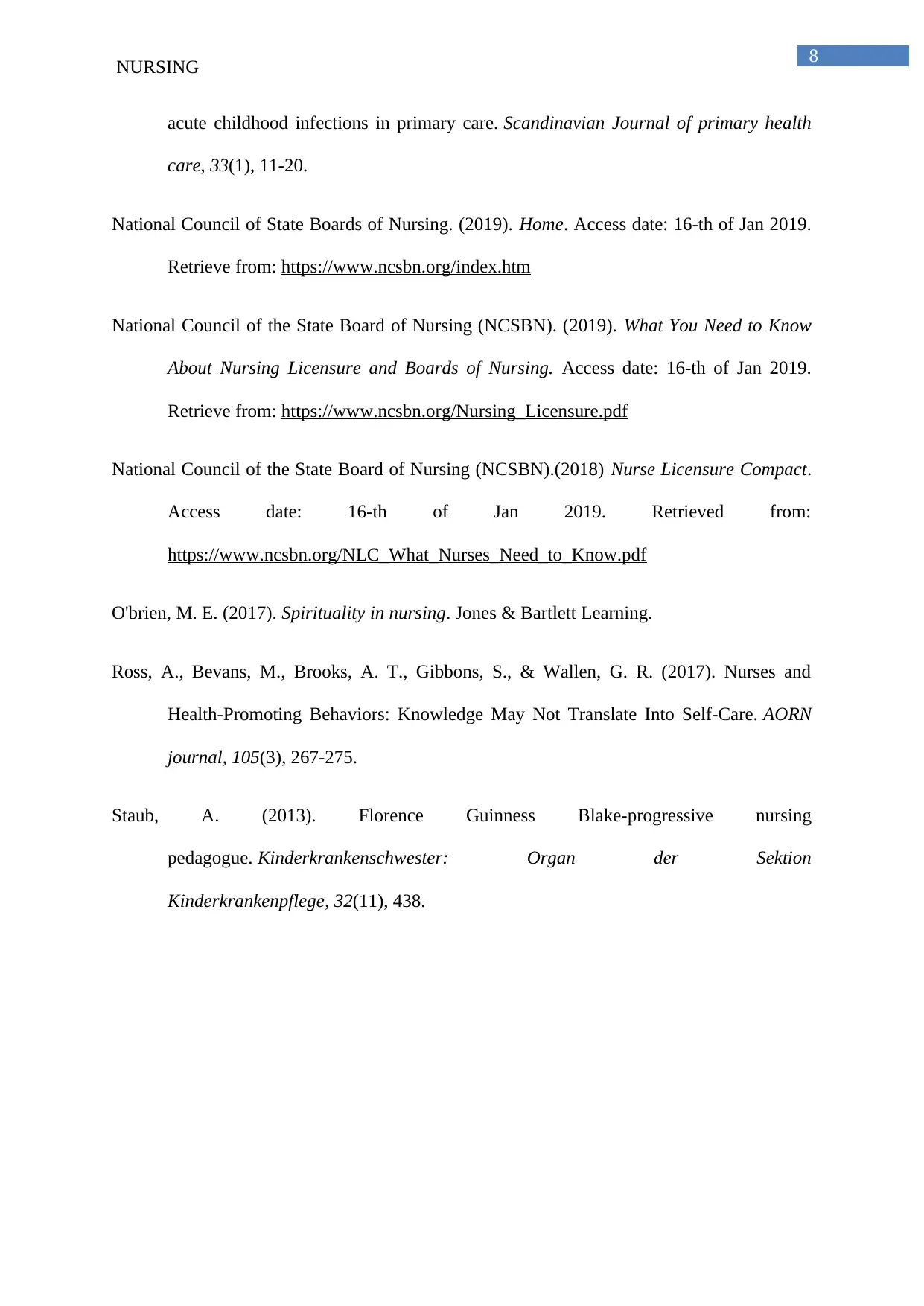
8
NURSING
acute childhood infections in primary care. Scandinavian Journal of primary health
care, 33(1), 11-20.
National Council of State Boards of Nursing. (2019). Home. Access date: 16-th of Jan 2019.
Retrieve from: https://www.ncsbn.org/index.htm
National Council of the State Board of Nursing (NCSBN). (2019). What You Need to Know
About Nursing Licensure and Boards of Nursing. Access date: 16-th of Jan 2019.
Retrieve from: https://www.ncsbn.org/Nursing_Licensure.pdf
National Council of the State Board of Nursing (NCSBN).(2018) Nurse Licensure Compact.
Access date: 16-th of Jan 2019. Retrieved from:
https://www.ncsbn.org/NLC_What_Nurses_Need_to_Know.pdf
O'brien, M. E. (2017). Spirituality in nursing. Jones & Bartlett Learning.
Ross, A., Bevans, M., Brooks, A. T., Gibbons, S., & Wallen, G. R. (2017). Nurses and
Health‐Promoting Behaviors: Knowledge May Not Translate Into Self‐Care. AORN
journal, 105(3), 267-275.
Staub, A. (2013). Florence Guinness Blake-progressive nursing
pedagogue. Kinderkrankenschwester: Organ der Sektion
Kinderkrankenpflege, 32(11), 438.
NURSING
acute childhood infections in primary care. Scandinavian Journal of primary health
care, 33(1), 11-20.
National Council of State Boards of Nursing. (2019). Home. Access date: 16-th of Jan 2019.
Retrieve from: https://www.ncsbn.org/index.htm
National Council of the State Board of Nursing (NCSBN). (2019). What You Need to Know
About Nursing Licensure and Boards of Nursing. Access date: 16-th of Jan 2019.
Retrieve from: https://www.ncsbn.org/Nursing_Licensure.pdf
National Council of the State Board of Nursing (NCSBN).(2018) Nurse Licensure Compact.
Access date: 16-th of Jan 2019. Retrieved from:
https://www.ncsbn.org/NLC_What_Nurses_Need_to_Know.pdf
O'brien, M. E. (2017). Spirituality in nursing. Jones & Bartlett Learning.
Ross, A., Bevans, M., Brooks, A. T., Gibbons, S., & Wallen, G. R. (2017). Nurses and
Health‐Promoting Behaviors: Knowledge May Not Translate Into Self‐Care. AORN
journal, 105(3), 267-275.
Staub, A. (2013). Florence Guinness Blake-progressive nursing
pedagogue. Kinderkrankenschwester: Organ der Sektion
Kinderkrankenpflege, 32(11), 438.
1 out of 9
Related Documents
Your All-in-One AI-Powered Toolkit for Academic Success.
+13062052269
info@desklib.com
Available 24*7 on WhatsApp / Email
![[object Object]](/_next/static/media/star-bottom.7253800d.svg)
Unlock your academic potential
© 2024 | Zucol Services PVT LTD | All rights reserved.





